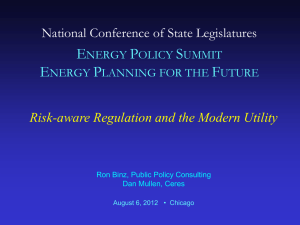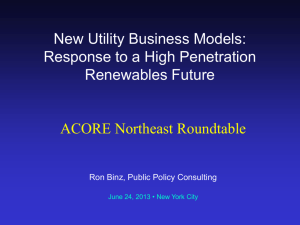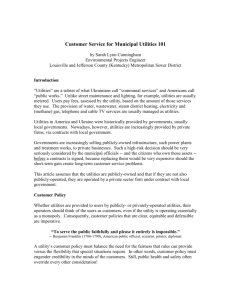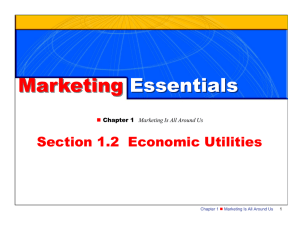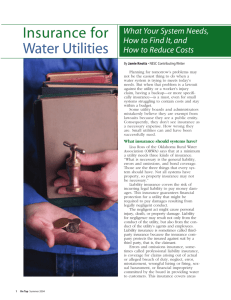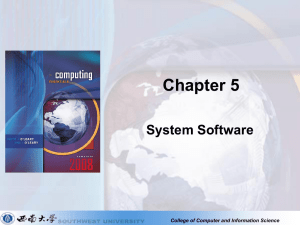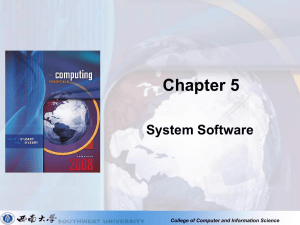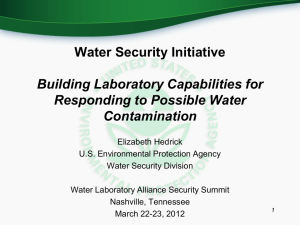Risk-aware Regulation and the Modern Utility
advertisement
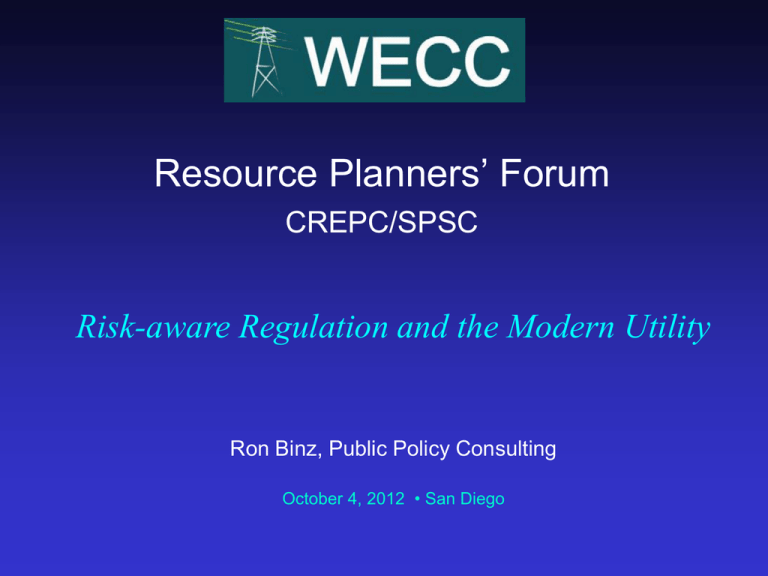
Resource Planners’ Forum CREPC/SPSC Risk-aware Regulation and the Modern Utility Ron Binz, Public Policy Consulting October 4, 2012 • San Diego Ron Binz • Public Policy Consulting • Center for the New Energy Economy, Colorado State University • Former Chairman Colorado PUC • Former Colorado Consumer Counsel • M.A. (Mathematics) University of Colorado; B.A. (Philosophy) St. Louis University • Makes wine, beer, cheese and pickles rbinz@rbinz.com • Authors – – – – Ron Binz Richard Sedano Denise Furey Dan Mullen Available at www.ceres.org High Stakes • The US electric industry is entering a “build cycle” with much higher investment than in recent history – Brattle Group estimates $2 trillion by 2030 • Causes – – – – – Aging infrastructure New transmission requirements Demand side and smart grid Much stronger air and water regulation, including GHGs Fuel economics • Challenges to utilities – – – – Flat load growth Distributed generation Uncertain economy Financial metrics less forgiving than in 1980s The US generation fleet is aging US Electric IOUs Rating History 1970 – 2010 4% AA AA AA A 22% BBB 46% BBB- 27% A AA A A A BBB BBB BBB 1% Source: Standard & Poor’s, Macquarie Capital The Key Question for Utilities and Their Regulators How do we ensure that $2 trillion is spent wisely? Notes • Unadjusted 2010 cost estimates were used for consistency CO2 costs • Costs for wind and photovoltaics have fallen sharply in last two years (faster than these 2010 estimates) With incentives • Cost of nuclear power has risen post-Fukushima (more than these 2010 estimates) No incentives A Catalog of Investment Risk • Cost-related • Time-related Seven categories in scoring… Construction cost overruns of risk– used Construction delays – – – – – – – – Capital •availability Construction cost Operational surprises • Fuel and Operating Fuel cost escalation New Regulations “Bet the• company” investments Management imprudence • Carbon Price Resources limited • Water Constraints Consumer reaction to rates • Capital Shock • Planning – Changing markets – Environmental regulations cost – Changes in load – Technology advancement – Catastrophe – Contingent projects – Government policies Cost Risk Risk Aware Planning at the Tennessee Valley Authority Seven Essential Strategies for Risk-Aware Regulation • • • • • • • Diversify utility supply Utilize robust planning processes Employ transparent ratemaking practice Use financial and physical hedges Hold utilities accountable Practice active, “legislative” regulation Reform, re-invent ratemaking policies Rewards for Sound Decision-making • • • • • • For consumers: keep more $$, quality For utilities: corporate health, predictability For investors: safety, value, expectations For employees: safety and welfare, pride For the regulatory process: public confidence For society: spending precious capital wisely Utilities 2020 • Foundation funded • Run by two former Colorado regulators named Ron • Advised by board of experts • Goal: to explore new business models and advocate new regulatory models to enable new utility business models to evolve. • Methods: – Interviews with utility CEOs and leading states regulators – Evaluations of other systems here and abroad – Dialogues with utility execs and commissioners What we’ve heard from utility CEOs: • CEOs want a clearer, more consistent direction from state energy policies • Utilities have little incentive for innovation, firm level efficiency • Commissions need a better understanding of the utility business and its needs • Utilities want certainty on climate policy • Utilities want healthier working relationships with commissioners and staff What we’ve heard from commissioners: • A primary concern is with increasing utility rates • Regulators are open to modifying the regulatory model; looking for ideas • Some commissioners are dissatisfied with the adversarial process • Many commissioners face severe barriers to communications with stakeholders, and even fellow commissioners • Commissions have inadequate resources Conclusions • Operating and regulating utilities will get more challenging. • Affirmative risk management can help avoid expensive mistakes. • The utility business model is changing; regulation must also change. • Investors are more vulnerable in this build cycle. • Risk shifting is not risk minimization; not all “credit positive” cost recovery mechanisms are sustainable policies. • Energy efficiency performs well in risk-aware regulation. • Regulators should be more than judges; they must also operate in “legislative mode.” • Regulators should strive to be informed, active, consistent, curious and courageous. Thanks for the invitation I look forward to your questions.
